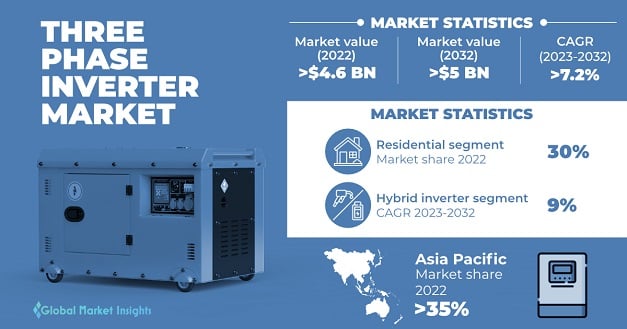Home > Energy & Power > Electrical Equipment > Voltage Regulators > Three Phase Inverter Market
Three Phase Inverter Market Size
- Report ID: GMI7040
- Published Date: Oct 2023
- Report Format: PDF
Three Phase Inverter Market Size
Three Phase Inverter Market size was valued at over USD 4.6 billion in 2022 and is anticipated to grow at a CAGR of over 7.2% between 2023 and 2032. The rising awareness of climate change and the need for sustainable energy sources have significantly boosted the demand for renewable energy systems.
Solar & wind power have witnessed widespread adoption. According to the World Economic Forum, 40% of the UK's electricity supply in 2022 was generated from solar, wind, biomass, and hydropower sources. Three-phase inverters are integral components of these systems, converting the variable DC power generated by solar panels or wind turbines into stable AC power for consumption or grid integration. Moreover, the increasing adoption of solar energy systems, both in the residential and commercial sectors, is significantly driving the demand for three-phase inverters.
For instance, in recent years, the U.S. has witnessed significant growth in solar PV installations. According to the Solar Energy Industry Association, the U.S. installed 20.2 gigawatts of solar PV capacity in 2022 to reach 142.3 gigawatts of the total installed capacity.
A Three Phase Inverter is an electronic device that converts direct current (DC) into alternating current (AC) with three separate waveforms, typically used in industrial and commercial applications. It ensures stable and efficient power supply by balancing the load across three phases, essential for various machinery, motors, and power systems requiring three-phase electricity.
| Report Attribute | Details |
|---|---|
| Base Year: | 2022 |
| Three Phase Inverter Market Size in 2022: | USD 2.5 Billion |
| Forecast Period: | 2022 to 2032 |
| Forecast Period 2022 to 2032 CAGR: | 7.3% |
| 2032 Value Projection: | USD 5 Billion |
| Historical Data for: | 2018 – 2022 |
| No. of Pages: | 200 |
| Tables, Charts & Figures: | 249 |
| Segments covered: | Type, Power rating, End-use Industry, and Region |
| Growth Drivers: |
|
| Pitfalls & Challenges: |
|
One of the primary challenges hindering the adoption of three-phase inverters, especially in residential & small-scale commercial applications, is the high initial installation cost. These inverters can be relatively expensive, which can deter some consumers, particularly in regions with limited financial resources.

